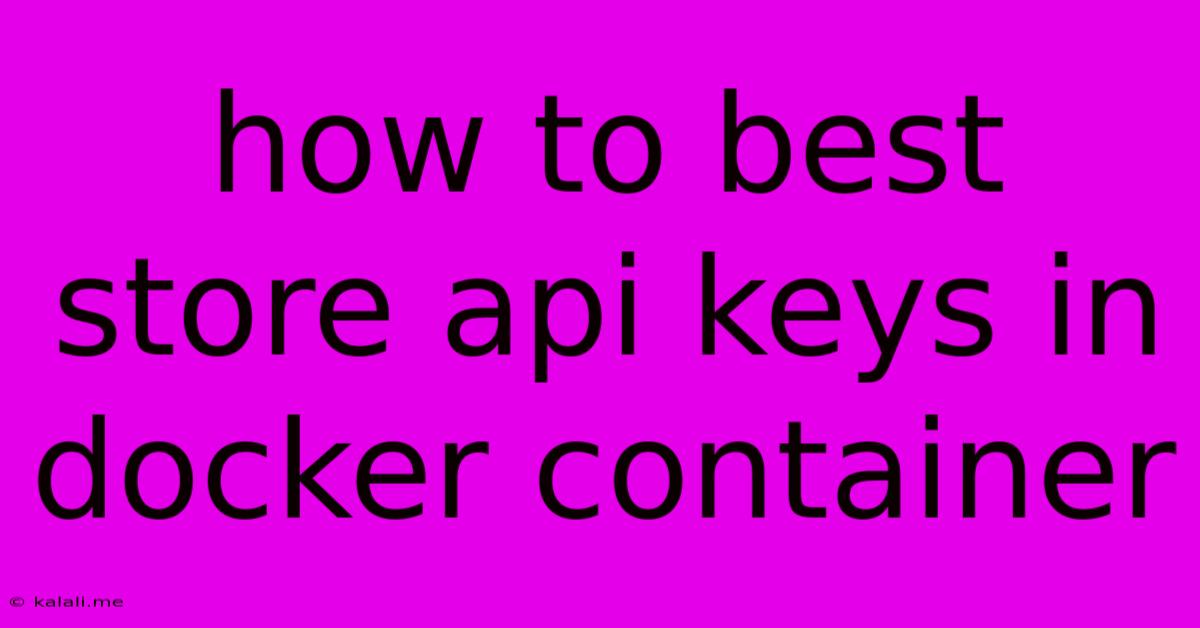How To Best Store Api Keys In Docker Container
Kalali
May 30, 2025 · 3 min read

Table of Contents
How to Best Store API Keys in Docker Containers: A Secure Approach
Meta Description: Securely managing API keys within Docker containers is crucial. This guide explores best practices, including environment variables, secrets management tools, and the importance of least privilege, ensuring your applications remain protected.
Storing API keys directly within your Docker images is a significant security risk. A compromised image means your keys are compromised. This article explores several best practices for securely storing and managing API keys within your Dockerized applications, minimizing the risk of exposure and ensuring compliance with security best practices. We'll cover several methods, comparing their pros and cons to help you choose the optimal strategy for your needs.
Why Not Store API Keys Directly in the Dockerfile?
Hardcoding API keys directly into your Dockerfile is the worst possible approach. This makes your keys visible in the image's layers, creating a significant vulnerability. Anyone with access to your image can easily extract the keys. This also makes it difficult to manage keys across different environments (development, staging, production), leading to inconsistencies and potential errors.
Best Practices for Secure API Key Management in Docker
Here are several superior methods for handling API keys within your Docker containers:
1. Environment Variables:
This is a widely used and relatively simple method. You pass your API keys as environment variables when running your container. This keeps the keys out of the image itself.
- Pros: Simple to implement, widely supported.
- Cons: Environment variables can be visible in process listings, though less readily accessible than in the Dockerfile itself. Security depends heavily on securing your host environment.
Example (using docker run):
docker run -e "API_KEY=your_actual_api_key" -e "DATABASE_PASSWORD=your_database_password" your-image-name
Example (using Docker Compose):
version: "3.9"
services:
my-app:
image: your-image-name
environment:
- API_KEY=your_actual_api_key
- DATABASE_PASSWORD=your_database_password
Remember to never commit these values to version control! Use .dockerignore to exclude sensitive files.
2. Secrets Management Tools:
Dedicated secrets management tools offer more robust security features. These tools often provide features such as encryption at rest and in transit, access control, and auditing. Popular options include:
- Docker Secrets: Docker's built-in secrets management is a good starting point for simple scenarios.
- Vault (HashiCorp): A comprehensive and feature-rich secrets management solution.
- AWS Secrets Manager, Azure Key Vault, Google Cloud Secret Manager: Cloud-provider specific solutions that integrate well with their respective ecosystems.
These tools typically involve storing the secrets externally, and your application fetches them at runtime. This further enhances security by keeping the keys out of the image and your host machine. This often requires modifying your application to interact with the secrets management service.
3. Least Privilege Principle:
Regardless of your chosen method, always follow the principle of least privilege. Grant your application only the necessary permissions to access the API. Avoid granting excessive permissions which could lead to greater damage in the event of a compromise.
4. Regular Rotation of API Keys:
Regularly rotate your API keys. This limits the impact of a potential breach. Your secrets management tool should aid in this process.
5. Image Scanning and Vulnerability Management:
Regularly scan your Docker images for vulnerabilities. This helps identify potential weaknesses that could be exploited to access your API keys.
Choosing the Right Approach
The best method depends on your specific needs and infrastructure. For simple applications with less stringent security requirements, environment variables might suffice. However, for production applications or those handling sensitive data, a dedicated secrets management tool is strongly recommended.
By implementing these best practices, you can significantly enhance the security of your API keys within your Docker containers, protecting your applications and your data. Remember that security is an ongoing process, and staying up-to-date with best practices and emerging threats is crucial.
Latest Posts
Latest Posts
-
Linux Sed Replace String In File
May 31, 2025
-
How To Allow Bad Names In Ubuntu Terminal
May 31, 2025
-
How To Get Rid Of Moss On A Brick Patio
May 31, 2025
-
Do Masters Have Major And Minor
May 31, 2025
-
How To Neutralize Urine Smell In Carpet
May 31, 2025
Related Post
Thank you for visiting our website which covers about How To Best Store Api Keys In Docker Container . We hope the information provided has been useful to you. Feel free to contact us if you have any questions or need further assistance. See you next time and don't miss to bookmark.